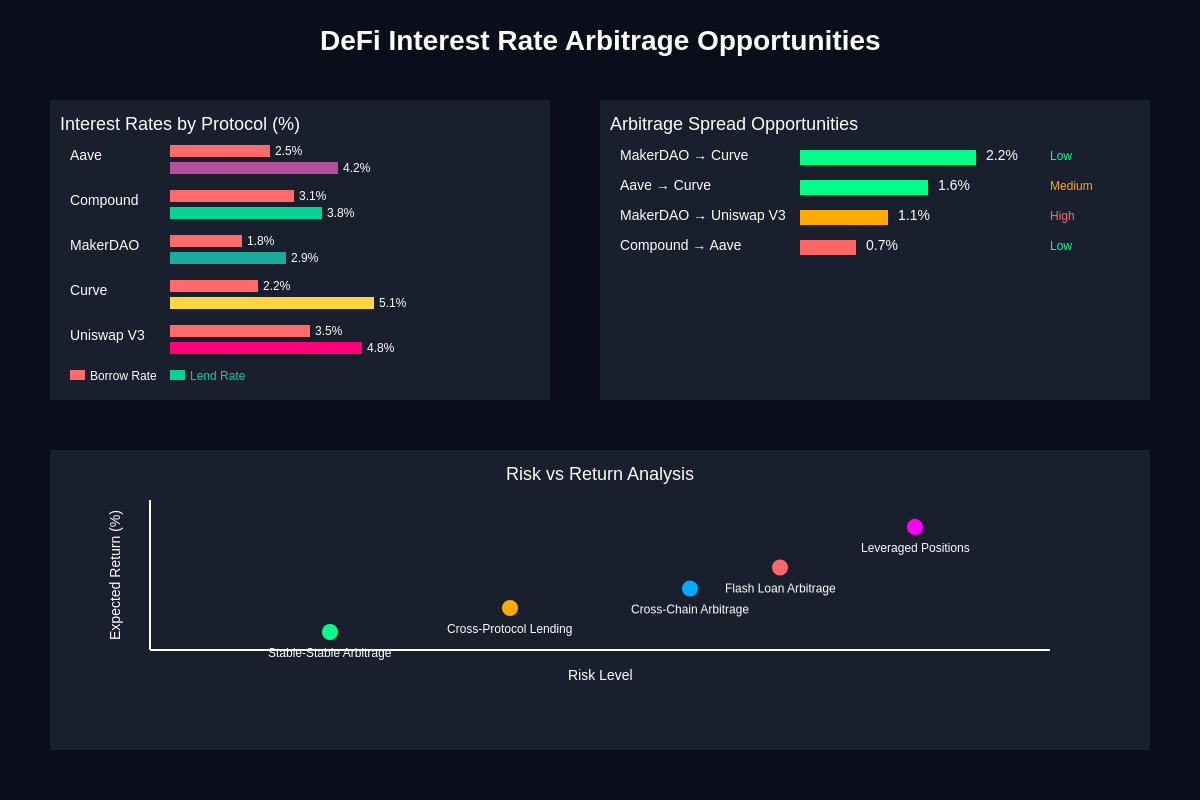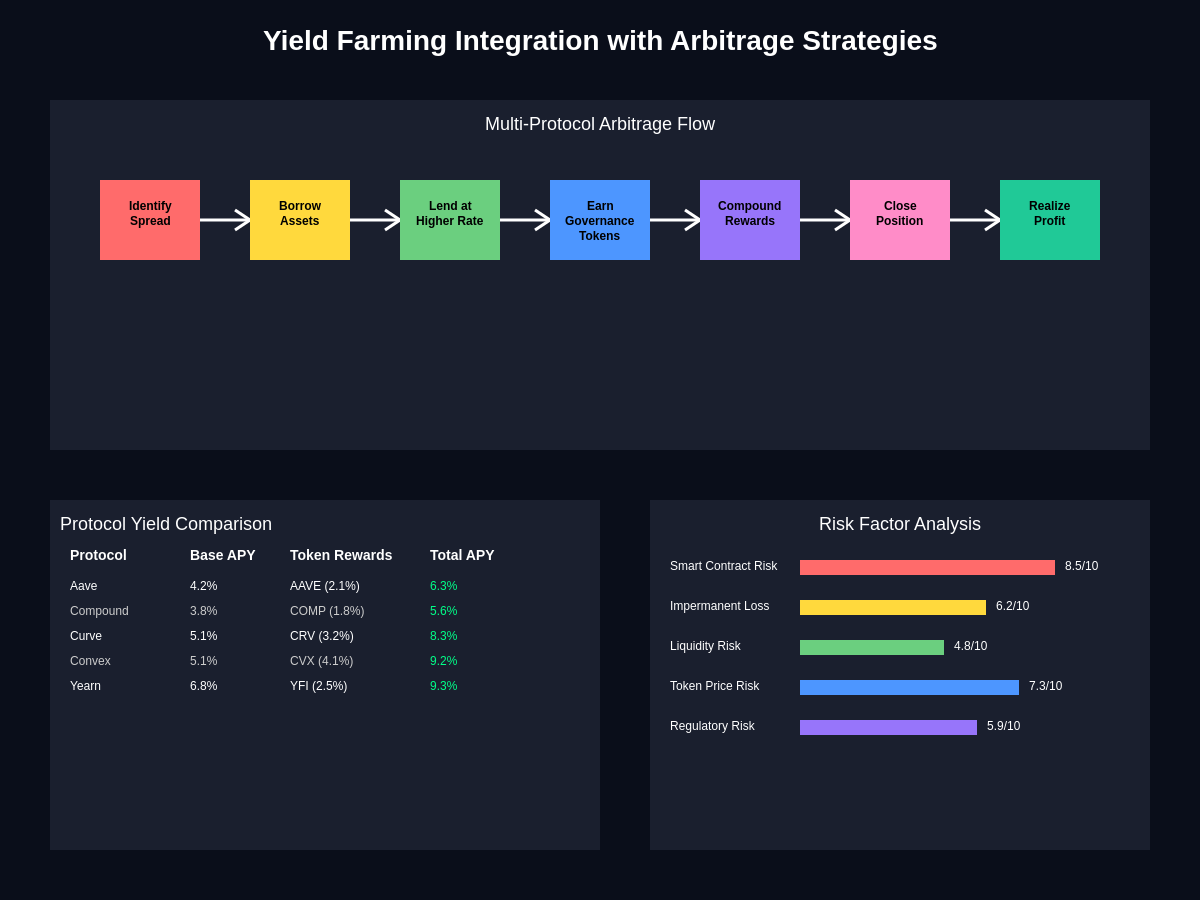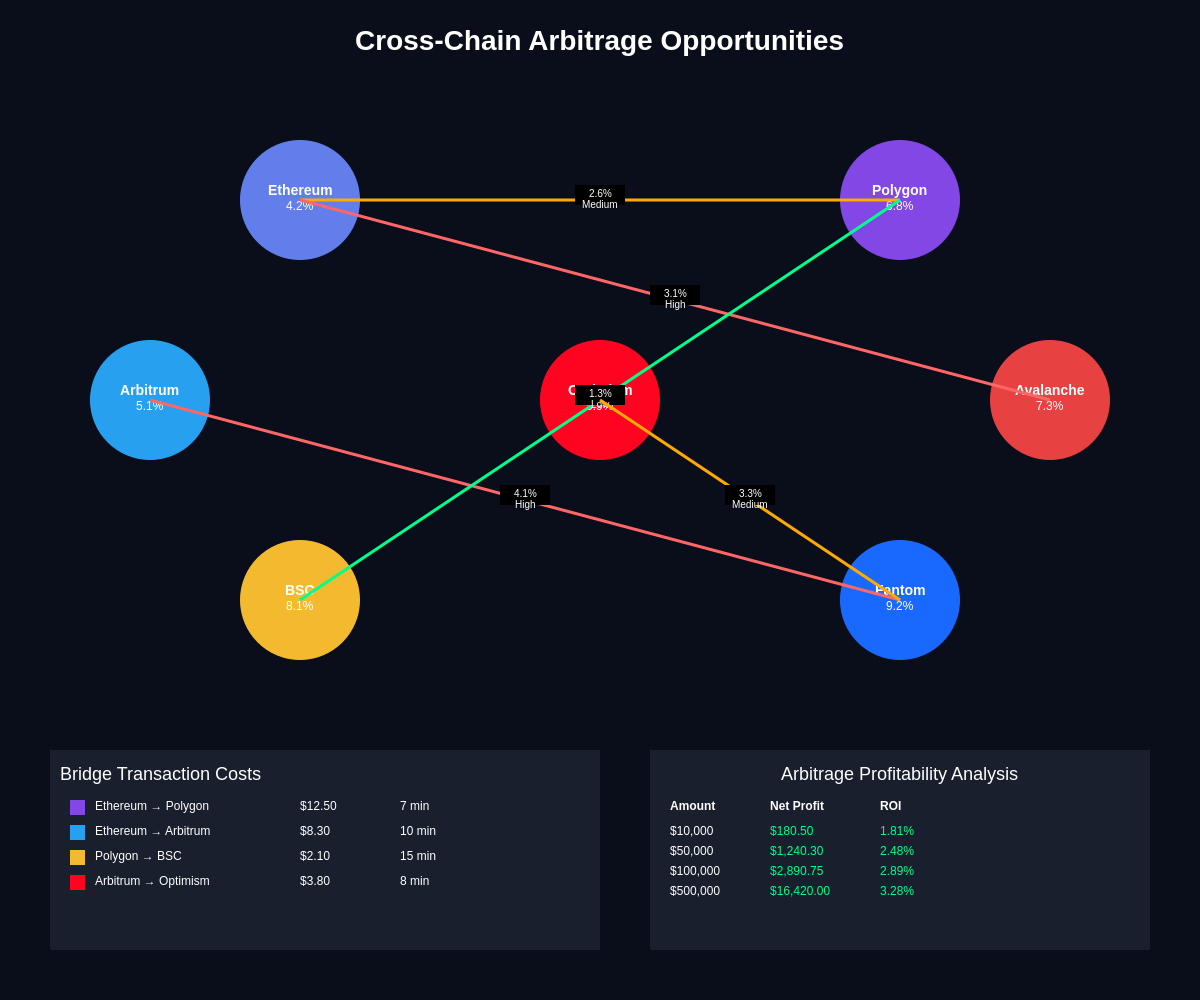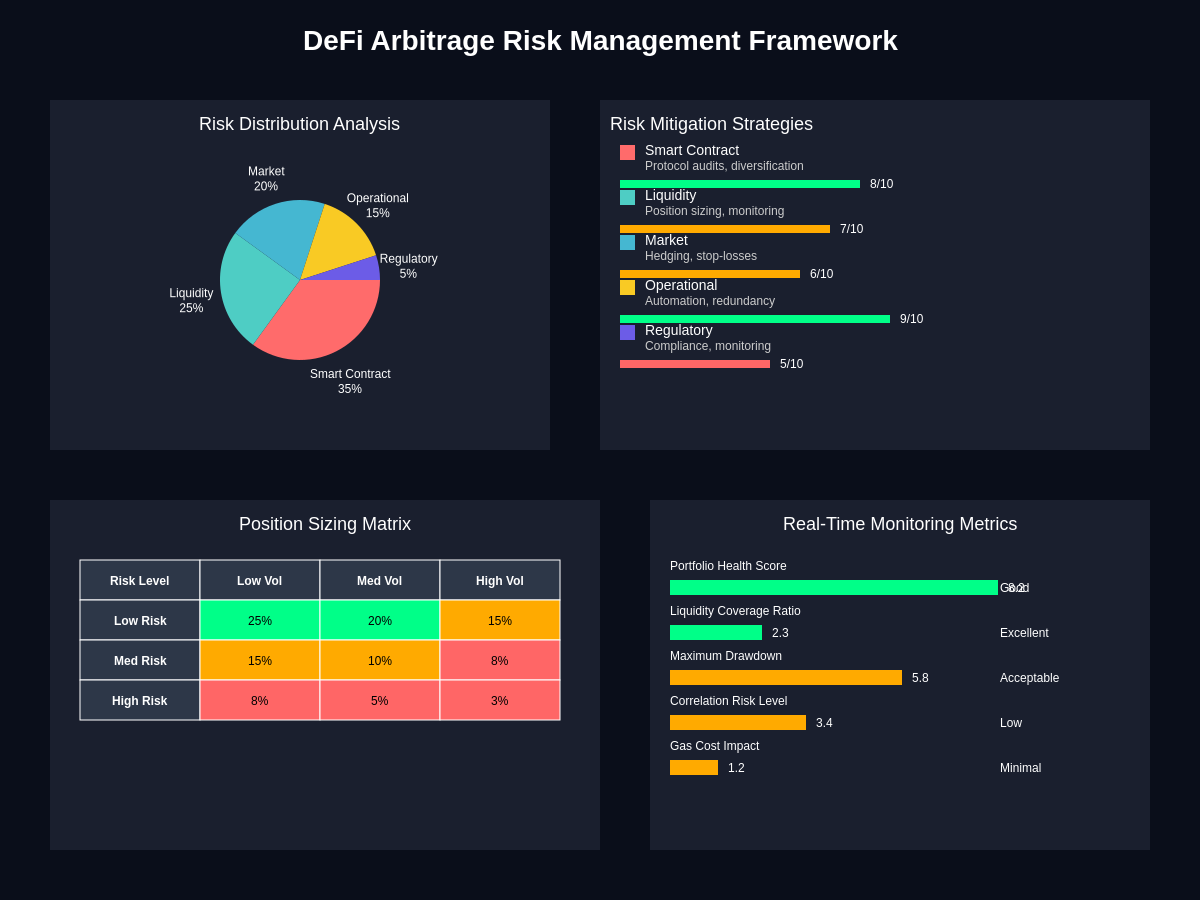The decentralized finance ecosystem has created unprecedented opportunities for sophisticated traders to capitalize on interest rate differentials across multiple protocols, platforms, and blockchain networks through systematic arbitrage strategies that exploit the inefficiencies and temporary imbalances inherent in this rapidly evolving financial infrastructure. Professional traders increasingly utilize advanced TradingView analysis tools to identify these profitable opportunities and execute complex multi-protocol strategies.
Understanding DeFi Interest Rate Dynamics
Interest rate arbitrage in decentralized finance represents a fundamental shift from traditional financial markets, where centralized institutions set rates through monetary policy and risk assessment committees, to a dynamic ecosystem where interest rates emerge organically from supply and demand interactions across dozens of automated protocols, each with unique risk profiles, token incentives, and governance mechanisms. These rates can vary dramatically even for identical underlying assets, creating substantial profit opportunities for traders who understand the complex interactions between lending protocols, yield farming mechanisms, and token incentive structures.

The decentralized nature of DeFi protocols means that interest rates respond immediately to market conditions without the delays and intermediation costs associated with traditional banking systems, creating both opportunities and challenges for arbitrage traders. While rates can adjust rapidly to eliminate inefficiencies, the complexity and fragmentation of the DeFi ecosystem often result in persistent rate differentials that skilled traders can exploit through careful analysis and strategic positioning.
Protocol-specific factors significantly influence interest rate determination including total value locked, utilization rates, governance token distributions, treasury management strategies, and smart contract risk premiums that reflect the relative security and maturity of different protocols. Understanding these factors enables arbitrage traders to predict and capitalize on rate movements before market inefficiencies are eliminated through natural arbitrage forces.
Fundamental Arbitrage Strategies and Execution
The most basic form of DeFi interest rate arbitrage involves borrowing assets at low rates from one protocol while simultaneously lending the same assets at higher rates on another platform, capturing the spread as profit while managing the inherent risks associated with smart contract exposure, liquidity constraints, and potential rate convergence. This strategy requires careful analysis of borrowing costs, lending yields, and the probability of maintaining profitable spreads throughout the intended holding period.
Advanced arbitrage strategies incorporate multiple protocols simultaneously, creating complex positions that can benefit from rate differentials while hedging against various risk factors including impermanent loss, protocol failure, and market volatility that could affect the underlying collateral used to secure leveraged positions. These strategies often involve recursive borrowing and lending across multiple platforms to amplify returns while managing risk through diversification and hedging mechanisms.
Cross-chain arbitrage represents a particularly sophisticated approach that exploits rate differentials between identical protocols deployed on different blockchain networks, though this strategy introduces additional complexity related to bridge security, transaction costs, and timing delays that can erode profits if not carefully managed. Successful cross-chain arbitrage requires deep understanding of inter-blockchain communication protocols and the ability to rapidly execute complex multi-step transactions across different networks.
Flash loan arbitrage enables traders to exploit temporary rate inefficiencies without requiring substantial initial capital, using uncollateralized loans that must be repaid within a single transaction to capture profits from momentary market imbalances. While flash loans eliminate capital requirements, they require sophisticated technical implementation and expose traders to smart contract risks and execution failures that can result in transaction costs without corresponding profits.
Risk Assessment and Management Frameworks
Smart contract risk represents perhaps the most significant concern for DeFi arbitrage traders, as protocol vulnerabilities, governance attacks, or economic exploits can result in total loss of deposited funds regardless of the profitability of the underlying arbitrage strategy. Comprehensive risk assessment requires technical analysis of smart contract code, governance mechanisms, economic incentives, and historical security performance to evaluate the probability and potential impact of protocol failures.
Liquidity risk management becomes crucial when executing large arbitrage positions, as insufficient market depth can prevent traders from unwinding positions at favorable prices or force them to accept significant slippage that erodes arbitrage profits. Effective liquidity management requires continuous monitoring of market conditions and the ability to rapidly adjust position sizes based on changing market depth and volatility conditions.
Regulatory risk presents an evolving challenge as governments worldwide develop frameworks for DeFi oversight that could affect protocol operations, token valuations, or trader obligations in ways that substantially impact arbitrage profitability. Traders must stay informed about regulatory developments and structure their operations to comply with applicable laws while maintaining operational flexibility to adapt to changing regulatory environments.
The interconnected nature of DeFi protocols means that seemingly independent arbitrage positions can become correlated during market stress events, amplifying losses beyond what individual risk assessments might suggest. Correlation analysis and stress testing help traders understand how their positions might perform during extreme market conditions and develop appropriate hedging strategies to protect against systemic risks.
Protocol Analysis and Opportunity Identification
Successful arbitrage trading requires systematic analysis of interest rate spreads across multiple protocols, incorporating factors such as protocol security, governance stability, token incentive structures, and historical performance to identify not only current opportunities but also predict future rate movements and arbitrage potential. Professional traders utilize sophisticated TradingView screening tools to monitor hundreds of token pairs and protocol combinations simultaneously.

Lending protocol comparison involves analyzing base interest rates, utilization curves, governance token rewards, and risk-adjusted returns to identify protocols offering favorable terms for both borrowing and lending activities. Different protocols employ varying interest rate models that respond differently to market conditions, creating opportunities for traders who understand these dynamics and can predict rate movements.
Yield farming integration allows arbitrage traders to enhance returns by earning governance tokens and additional rewards while maintaining arbitrage positions, though this requires careful analysis of token emission schedules, vesting requirements, and the potential impact of token price volatility on overall strategy performance. The complexity of yield farming rewards necessitates sophisticated accounting and tax planning to accurately assess true returns.
Governance token analysis becomes crucial when evaluating long-term arbitrage opportunities, as changes in protocol parameters, fee structures, or incentive mechanisms can dramatically affect the viability of arbitrage strategies. Active participation in protocol governance or deep understanding of governance dynamics enables traders to anticipate and position for changes that could create or eliminate arbitrage opportunities.
Technical Implementation and Automation
Automated arbitrage systems enable traders to capitalize on brief market inefficiencies that manual trading cannot effectively exploit, using sophisticated algorithms to monitor multiple protocols simultaneously and execute trades within seconds of opportunity identification. These systems require robust technical infrastructure including reliable data feeds, low-latency execution capabilities, and comprehensive error handling to operate effectively in the fast-paced DeFi environment.
Smart contract development for arbitrage trading involves creating custom contracts that can interact with multiple protocols within single transactions, enabling complex strategies that might be impossible or uneconomical to execute through traditional wallet interfaces. These contracts must be thoroughly tested and audited to prevent costly errors or security vulnerabilities that could result in fund loss.
Gas optimization becomes critical for profitable arbitrage execution, as network congestion can dramatically increase transaction costs and eliminate profit margins from small arbitrage opportunities. Advanced traders employ sophisticated gas management strategies including transaction batching, timing optimization, and dynamic fee adjustment to maximize profitability while ensuring reliable trade execution.
Monitoring and alerting systems enable traders to respond quickly to changing market conditions and emerging arbitrage opportunities, using real-time data analysis to identify profitable trades and risk management triggers. These systems must balance sensitivity with reliability to avoid false signals while ensuring that genuine opportunities are not missed due to delayed notifications.
Market Dynamics and Competitive Landscape
The competitive landscape for DeFi arbitrage continues to evolve as more sophisticated traders enter the market with advanced tools and strategies, gradually reducing the size and duration of arbitrage opportunities while increasing the technical complexity required for profitable trading. This evolution mirrors traditional financial markets where initial inefficiencies are gradually eliminated through competition, forcing traders to develop increasingly sophisticated approaches to maintain profitability.

Institutional adoption of DeFi arbitrage strategies brings significant capital and technical expertise to the market, potentially reducing opportunities for individual traders while also increasing market efficiency and liquidity. Understanding institutional trading patterns and positioning can help smaller traders identify niches and opportunities that large institutions might overlook or find uneconomical to pursue.
Market maker dynamics significantly influence arbitrage opportunities as automated market makers respond to trading activity and external price feeds, creating temporary inefficiencies that skilled arbitrage traders can exploit. The interaction between AMM algorithms and external market forces creates complex patterns that require sophisticated analysis to understand and predict effectively.
Cross-protocol integration and composability continue to create new arbitrage opportunities as protocols develop enhanced interoperability features and new financial primitives that enable previously impossible trading strategies. Staying current with protocol developments and understanding emerging opportunities requires continuous research and experimentation with new tools and techniques.
Economic Theory and Market Efficiency
Interest rate arbitrage in DeFi serves a crucial market function by connecting fragmented liquidity pools and ensuring that rates for similar risk profiles converge across different protocols, improving overall market efficiency and capital allocation within the decentralized finance ecosystem. This arbitrage activity helps establish fair pricing for risk and liquidity across the DeFi landscape while providing essential market-making services.
The relationship between arbitrage activity and market maturity suggests that as DeFi markets develop and become more efficient, traditional arbitrage opportunities may diminish while new, more sophisticated strategies emerge to capitalize on subtler market inefficiencies. This evolution requires traders to continuously adapt their approaches and develop new capabilities to remain competitive in an increasingly efficient market environment.
Behavioral economics factors influence DeFi arbitrage opportunities as individual users and smaller traders may not respond optimally to rate changes, creating persistent inefficiencies that sophisticated arbitrage traders can exploit. Understanding user behavior patterns and decision-making biases helps identify sustainable arbitrage opportunities that persist despite market competition.
The impact of monetary policy and macroeconomic conditions on DeFi interest rates creates broader arbitrage opportunities between traditional finance and decentralized protocols, particularly during periods of monetary policy shifts or economic uncertainty when traditional and DeFi rates may diverge significantly. Advanced traders monitor these relationships using comprehensive TradingView economic calendars to identify macro-driven arbitrage opportunities.
Regulatory Considerations and Compliance
The evolving regulatory landscape for DeFi activities requires arbitrage traders to carefully consider compliance obligations including tax reporting, securities regulations, and anti-money laundering requirements that may apply to their trading activities. Different jurisdictions are developing varying approaches to DeFi regulation, creating compliance complexity for traders operating across multiple protocols and geographic regions.
Tax optimization strategies for arbitrage trading must account for the complex interactions between lending income, borrowing costs, token rewards, and capital gains across multiple protocols and jurisdictions. Professional tax planning becomes essential for maintaining profitability while ensuring compliance with applicable tax obligations and reporting requirements.
The pseudonymous nature of many DeFi protocols creates both opportunities and challenges for regulatory compliance, as traders must balance privacy considerations with potential compliance obligations and the evolving expectations of regulatory authorities regarding transaction transparency and reporting.
Future regulatory developments could significantly impact arbitrage profitability through changes in tax treatment, reporting requirements, or restrictions on certain types of trading activities. Staying informed about regulatory trends and maintaining operational flexibility to adapt to changing requirements becomes crucial for long-term success in DeFi arbitrage trading.
Advanced Strategies and Sophisticated Techniques
Multi-asset arbitrage strategies involve simultaneously exploiting rate differentials across different cryptocurrencies and stablecoins, creating complex positions that can benefit from both interest rate spreads and price movements while managing correlation risks and currency exposure. These strategies require sophisticated risk management and hedging techniques to maintain profitability while controlling volatility.

Leveraged arbitrage positions amplify potential returns by using borrowed capital to increase position sizes, though this also magnifies risks and requires careful monitoring of margin requirements, liquidation risks, and interest costs that can quickly erode profits if markets move unfavorably. Successful leveraged arbitrage requires precise risk management and the ability to rapidly adjust positions as market conditions change.
Options integration enables arbitrage traders to enhance returns and manage risks through strategic use of derivatives that can provide downside protection, leverage exposure to rate movements, or generate additional income through premium collection. Understanding options pricing and volatility dynamics becomes crucial for effectively incorporating derivatives into arbitrage strategies.
Synthetic asset creation through complex derivatives positions allows traders to gain exposure to arbitrage opportunities without directly holding underlying assets, potentially reducing custody risks and regulatory exposure while maintaining profit potential. These strategies require deep understanding of derivatives markets and sophisticated risk management capabilities.
Technology Infrastructure and Operational Requirements
Reliable data infrastructure forms the foundation of successful arbitrage trading, requiring access to real-time protocol data, accurate interest rate information, and comprehensive market data across multiple blockchains and protocols. Building and maintaining this infrastructure requires significant technical expertise and ongoing investment in data sources and processing capabilities.
Execution infrastructure must provide low-latency access to multiple blockchain networks with the ability to rapidly submit transactions and manage gas costs during periods of network congestion. This requires sophisticated transaction management systems and potentially dedicated blockchain infrastructure to ensure reliable trade execution.
Security considerations for arbitrage trading infrastructure include protection of private keys, secure communication channels, and comprehensive operational security practices to prevent unauthorized access or compromise of trading systems. The high-value nature of arbitrage positions makes security a critical operational requirement that cannot be overlooked.
Disaster recovery and business continuity planning become essential as arbitrage operations scale and depend on complex technical infrastructure that could fail during critical market periods. Comprehensive backup systems and contingency plans help ensure operational continuity and protect against catastrophic losses due to technical failures.
Performance Measurement and Optimization
Risk-adjusted return measurement for arbitrage strategies must account for the various risk factors including smart contract exposure, liquidity constraints, and correlation risks that traditional performance metrics might not capture. Developing appropriate benchmarks and performance measurement frameworks helps traders evaluate strategy effectiveness and identify areas for improvement.
Transaction cost analysis becomes crucial for optimizing arbitrage profitability, as network fees, slippage, and other execution costs can significantly impact returns, particularly for smaller arbitrage opportunities. Sophisticated cost modeling and optimization techniques help maximize net profitability while maintaining reliable execution.
Capital efficiency optimization involves structuring arbitrage positions to maximize returns per unit of capital deployed while managing risks and maintaining operational flexibility. This requires careful analysis of leverage ratios, collateral requirements, and opportunity costs to ensure optimal capital allocation across different strategies and market conditions.
Performance attribution analysis helps traders understand which components of their arbitrage strategies generate the most value and identify areas where improvements could enhance overall performance. This analysis enables continuous strategy refinement and adaptation to changing market conditions.
Future Outlook and Evolution
The continued maturation of DeFi markets will likely reduce traditional arbitrage opportunities while creating new, more sophisticated profit opportunities that require advanced technical capabilities and market understanding. Successful arbitrage traders must continuously evolve their strategies and capabilities to remain competitive in an increasingly efficient market environment.
Cross-chain infrastructure developments will expand arbitrage opportunities across different blockchain ecosystems while also introducing new technical complexities and risk factors that traders must understand and manage. The growth of interoperability solutions creates both opportunities and challenges for arbitrage traders.
Institutional integration with DeFi protocols will bring additional liquidity and competition to arbitrage markets while also potentially creating new opportunities for traders who can provide specialized services or access unique market segments. Understanding institutional behavior and requirements becomes increasingly important for individual arbitrage traders.
Regulatory clarity will likely reduce some uncertainty while potentially restricting certain types of arbitrage activities, requiring traders to adapt their strategies and operations to comply with evolving regulatory requirements while maintaining profitability. Professional traders track these developments through comprehensive market analysis tools to stay ahead of regulatory changes.
Risk Management Excellence
Comprehensive risk management frameworks for DeFi arbitrage must address multiple risk categories simultaneously including smart contract risks, liquidity risks, market risks, operational risks, and regulatory risks that can interact in complex ways during market stress periods. Effective risk management requires continuous monitoring, stress testing, and scenario analysis to ensure positions remain viable under various market conditions.
Position sizing methodologies must account for the unique risk characteristics of DeFi arbitrage including the potential for rapid and complete loss of funds due to smart contract failures or exploit events. Conservative position sizing combined with diversification across multiple protocols and strategies helps protect capital while maintaining reasonable return potential.
Hedging strategies for arbitrage positions can help protect against adverse market movements, protocol failures, or changes in market conditions that could eliminate arbitrage opportunities. Effective hedging requires understanding correlation structures and the availability of appropriate hedging instruments within the DeFi ecosystem.
Stress testing and scenario analysis help traders understand how their positions might perform during extreme market conditions including black swan events, protocol failures, or regulatory changes that could dramatically impact market structure and arbitrage opportunities. Regular stress testing enables proactive risk management and position adjustment before problems arise.
Disclaimer: This article is for educational and informational purposes only and does not constitute financial, investment, legal, or tax advice. Cryptocurrency and DeFi trading involves substantial risk of loss and may not be suitable for all investors. Interest rate arbitrage strategies carry significant risks including smart contract vulnerabilities, impermanent loss, liquidity constraints, and potential total loss of capital. Past performance does not guarantee future results. Readers should conduct their own research and consult with qualified financial advisors before making any investment decisions. The regulatory landscape for DeFi activities is rapidly evolving and may affect the legality and profitability of arbitrage strategies. All trading activities should comply with applicable laws and regulations in your jurisdiction.